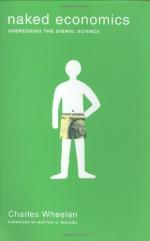
|
| Name: _________________________ | Period: ___________________ |
This test consists of 5 multiple choice questions, 5 short answer questions, and 10 short essay questions.
Multiple Choice Questions
1. When did the Great Depression begin in the United States?
(a) 1886.
(b) 1905.
(c) 1918.
(d) 1929.
2. In Chapter 13, the author states that according to the United Nations Food and Agriculture Organization, over how many people in this world don't get enough to eat?
(a) 1 billion.
(b) 350 million.
(c) 800 million.
(d) 100 million.
3. The U.S. adopted a silver standard based on the Spanish milled dollar in what year?
(a) 1866.
(b) 1835.
(c) 1785.
(d) 1802.
4. According to the author in Chapter 11, the problem with this gold standard was the central bank could do what?
(a) Require collateral.
(b) Devalue the currency.
(c) Manipulate exchange rates.
(d) Charge interest.
5. When was the Federal Reserve Act enacted?
(a) 1892.
(b) 1812.
(c) 1913.
(d) 1776.
Short Answer Questions
1. The GDP does not consider economic activity that is what, according to the author in Chapter 9?
2. In Chapter 12, the author states that statistics clearly show that the world is growing more economically what?
3. What is the economic policy of restraining trade between states through methods such as tariffs on imported goods, restrictive quotas, and a variety of other government regulations designed to allow "fair competition" between imports and goods and services produced domestically?
4. In order to get a true understanding of an economy, there are nine factors one should consider along with the GDP according to the author in Chapter 9. What is the fifth?
5. Economists call the cycle of recession and recovery what, according to the author in Chapter 9?
Short Essay Questions
1. How does the author address the issue of protectionism in Chapter 12?
2. What does the author remark about globalization in the beginning of Chapter 12? What are the benefits of global trade?
3. How is the decline of Iceland's economy described in Chapter 11?
4. What does the GDP not factor in, according to the author in Chapter 9?
5. Discuss the growth rate of globalizing countries as discussed in Chapter 12. How did the globalizing countries benefit?
6. How does the author describe public policy in Chapter 8? What problems do politicians face in this area?
7. How is the gold standard described in Chapter 11? What is the problem with the gold standard?
8. How does the author describe the relationship between the GDP and quality of life in India in Chapter 9?
9. What is the HDI? How is it described in Chapter 9?
10. What did the French president propose in measuring economies, as described in Chapter 9? What criticism did he receive?
|
This section contains 894 words (approx. 3 pages at 300 words per page) |

|




